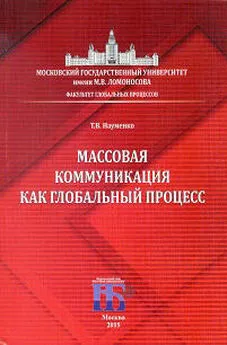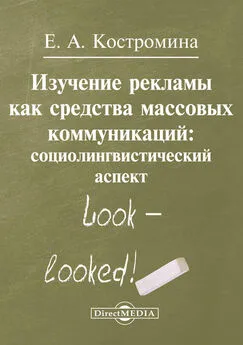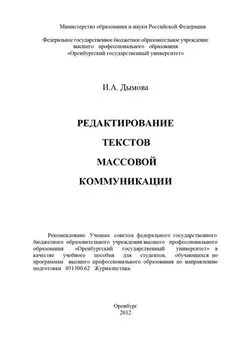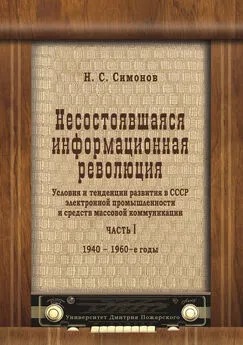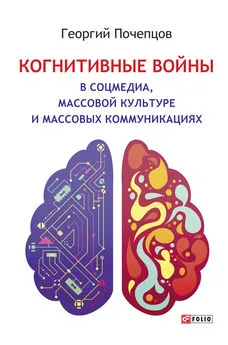Ричард Харрис - Психология массовых коммуникаций
- Название:Психология массовых коммуникаций
- Автор:
- Жанр:
- Издательство:2002
- Год:2002
- Город:Санкт-Петербург
- ISBN:5-93878-033-0
- Рейтинг:
- Избранное:Добавить в избранное
-
Отзывы:
-
Ваша оценка:
Ричард Харрис - Психология массовых коммуникаций краткое содержание
«Предупреждён – значит вооружён». Такой эпиграф мог бы открывать эту книгу. И не имеет значения, кто возьмёт её в руки. Специалист почерпнёт в ней новые приёмы и подходы к анализу стратегии и тактики СМИ. Любознательный обыватель научится обеспечивать собственную информационную безопасность.
Кроме того картина информационного ландшафта современного общества от предвыборного управления массовым сознанием до рекламы памперсов оказывается настолько захватывающей, что однажды начав читать эту книгу, вы уже не оставите её недочитанной.
Психология массовых коммуникаций - читать онлайн бесплатно полную версию (весь текст целиком)
Интервал:
Закладка:
Wenner, L. A., Gantz, W. (1989). The audience experience with sports on television. In: L. A, Wenner (Ed.). Media, sports, society (p. 241–269). Newbury Park, CA: Sage.
Wernick, R. (1996, August). Let's hear it for the lowly sound bite! Smithsonian, 27(5), 62–65.
Weston, M.A. (1996). Native Americans in the news: Images of Indians in the twentieth century press. West-port, CT: Greenwood.
Weymouth, L. (1981, January-February). Walter Cronkit remembers. Washington Journalism Review, p. 23.
Whannel, G. (1992). Fields in vision: Television sport and cultural transformation. London: Routledge. What's so funny? (1997, December 20). The Economist. (Reprinted in: World Press Review, March 1998, p. 18–19.)
What's up, doc? (1995, February 5). Manhattan Mercury, p. A7.
Whillock, R. K. (1997). Cyber-politics: The on-line strategies of '96. American Behavioral Scientist, 40, 1208–1225.
White, L. A. (1979). Erotica and aggression: The influence of sexual arousal, positive affect, and negative affect on aggressive behavior. Journal of Personality and Social Psychology, 37, 591–601.
Wilcox, B. L. (1987). Pornography, social science, and politics: When research and ideology collide. American Psychologist, 42, 941–943.
Wilhoit, G. C., de Bock, H. (1976). "All in the Family" in Holland. Journal of Communication, 26(1), 75–84.
Will, E. (1987). Women in media. The Other Side, 23(4). 44–46.
Williams, B. (1979, November). Report of the Departmental Committee on Obscenity and Film Censorship. London: Her Majesty's Stationery Office. Command 7772
Williams. F., Phillips, A., Lum, P. (1985). Gratifications associated with new communication technologies. In: K. Rosengren, L. Wenner, P. Palmgreen (Eds.). Mediagratifications research: New perspectives. Beverly Hills, CA: Sage.
Williams, F., Strover, S., Grant, A. E. (1994). Social aspects of new media technologies. In: J. Bryant and D. Zillmann (Eds.). Media effects: Advances in theory and research (p. 463–482). Hillsdale, NJ: Lawrence Eribaum Associates.
Williams, Т . М . (Ed.). (1986). The impact of television. Orlando, FL: Academic Press. Willwerth. J. (1993, February 15). It hurts like crazy. Time, 53.
Wilson, B. J. (1987). Reducing children's emotional reactions to mass media through rehearsed explanation and exposure to a replica of a fear object. Human Communication Research, 14, 3–26.
Wilson, B. J. (1989). Desensitizing children's emotional reactions to the mass media. Communication Research, 16, 723–745.
Wilson, B. J. (1991). Children's reactions to dreams conveyed in mass media programming. Communication Research, 18. 283–305.
Wilson, B. J., Cantor, J. (1987). Reducing fear reactions to mass media: Effects of visual exposure and verbal explanation. In: M. McLaughlin (Ed.). Communication yearbook 10 (p. 553–573). Newbury Park, CA: Sage.
Wilson, B. J., Hoffner, C., Cantor, J. (1987). Children's perceptions of the effectiveness of techniques to reduce fear from mass media. Journal of Applied Developmental Psychology, 8, 39–52.
Wilson, B. J., Linz, D., Donnerstein, E., Stipp, H. (1992). The impact of social issue television programming on attitudes toward rape. Human Communication Research, 19, 179–208.
Wilson, B. J., Weiss, A. J. (1993). The effects of sibling coviewing on preschoolers' reactions to a suspenseful movie sequence. Communication Research, 20, 214–248.
Wilson, C. C. II, Gutierrez, F. (1995). Race, multiculturalism, and the media: From mass to class communication. Thousand Oaks. CA: Sage.
Wilson, J. R., Wilson, S. L. R. (1998). Mass media/ Mass culture (4th ed.). New York: McGraw-Hill.
Winbush, D. (1989, June 19). Bringing Satan to heel. Time, 54–55.
Windahl, S. (1981). Uses and gratifications at the crossroads. In: G. C. Wilhoit H. de Bock (Eds.). Mass communication review yearbook (Vol. 2, p. 174–185). Newbury Park, CA: Sage.
Winn, M. (1977). The plug-in drug: Television, children, and the family. New York: Viking Penguin. Winn, M. (1987). Unplugging the plug-in drug. New York: Penguin Books.
Witte, K. (1992). Preventing AIDS through persuasive communications. In: F. Korzenny S. Tmg-Toomey (Eds.). Mass media effects across cultures (p. 67–86). Newbury Park, CA: Sage.
Wittebols, J. H. (1991). The politics and coverage of terrorism: From media images to public consciousness. Communication Theory, I, 253–266.
Wober, J. M. (1978). Televised violence and paranoid perception: The view from Great Britain. Public Opinion Quarterly, 42, 315–321.
Wober, J. M. (1986). The lens of television and the prism of personality. In: J. Bryant D. Zillmann (Eds.). Perspectives on media effects (p. 205–231). Hillsdale, NJ: Lawrence Eribaum Associates.
Wober, J. M., Gunter, B. (1986). Television audience research at Britain's Independent Broadcasting Authority, 1974–1984. Journal of Broadcasting Electronic Media, 30, 15-31.
Wood, W, Wong, F. Y, Chachere, J. G. (1991). Effects of media violence on viewers' aggression in unconstrained social interaction. Psychological Bulletin, 109, 371–383.
Wresch, W. (1996). Disconnected: Haves and have-nots in the information age. New Brunswick, NJ: Rutgers University Press.
Wright, C. R. (1986). Mass communication: A sociological perspective (3rd ed.). New York: Random House. Wright, J. C., Kunkel, D., Pinon, M., Huston, A. C. (1989). How children reacted to televised coverage of the space shuttle disaster. Journal of Communication, 39(2), 27–45.
Wright. J. C., St. Peters, M., Huston, A. C. (1990). Family television use and its relation to children's cognitive skills and social behavior. In: J. Bryant (Ed.). Television and the American family (p. 227–251). Hillsdale, NJ: Lawrence Eribaum Associates.
Wroblewski. R., Huston, A. C. (1987). Televised occupational stereotypes and their effects on early adolescence: Are they changing? Journal of Early Adolescence, 7, 283–297
Wulf, S. (1996. July 29). An old sweet song. Time, 67–69.
Wyer, R. S., Collins, J. E. (1992). A theory of humor elicitation. Psychological Review, 99, 663–688.
Yang, N.. Linz, D. (1990). Movie ratings and the content of adult videos: The sex-violence ratio. Journal of Communication, 40(2), 28–32.
Yorke, D., Kitchen, P. (1985). Channel flickers and video speeders. Journal of Advertising Research, 25(2), 21–25.
Young, В . М . (1991). Television advertising and children. New York: Oxford University Press.
Zechmeister, E. В ., Johnson, J. E. (1992). Critical thinking: A functional approach. Pacific Grove, CA: В rooks-Cole.
Zeiizer, B. (1992). CNN, the Gulf War, and journalistic practice. Journal of Communication, 42(1), 66–81.
Zillmann, D. (1978): Attribution and mis-attribution of excitatory reactions. In: J. H. Harvey, W. J. Ickes. R. E Kidd (Eds.). New directions in attribution research (Vol. 2, p. 335–368). Hillsdale, NJ: Lawrence Eribaum Associates.
Zillmann, D. (1980). Anatomy of suspense. In: P H. Tannenbaum (Ed.). The entertainment functions of television (p. 133–163). Hillsdale, NJ: Lawrence Eribaum Associates.
Zillmann, D. (1983). Transfer of excitation in emotional behavior. In: J. T. Cacioppo R. E. Petty (Eds.). Social psychophysiology (p. 215–240). New York: Guilford Press.
Zillmann, D. (1984). Connections between sex and aggression. Hillsdale, NJ: Lawrence Eribaum Associates.
Zillmann, D. (1991 a). Television viewing and physiological arousal. In: J. Bryant D. Zillmann (Eds.). Responding to the screen: Reception and reaction processes (p. 103–133). Hillsdale, NJ: Lawrence Eribaum Associates.
Zillmann, D. (1991 b). Empathy: Affect from bearing witness to the emotions of others. In: J. Bryant D. Zillmann (Eds.). Responding to the screen: Reception and reaction processes (p. 135—167). Hillsdale, NJ: Lawrence Eribaum Associates.
Zillmann, D. (1991 c). The logic of suspense and mystery. In: J. Bryant D. Zillmann (Eds.). Responding to the screen: Reception and reaction processes (p. 281–303). Hillsdale, NJ: Lawrence Eribaum Associates.
Zillmann, D., Bryant, J. (1982). Pornography, sexual callousness, and the trivialization of rape. Journal of Communication, 32(4), 10–21.
Zillmann, D., Bryant. J. (1984). Effects of massive exposure to pornography. In: N. M. Malamuth E. Donnerstein (Eds.). Pornography and sexual aggression (p. 115–141). Orlando, FL: Academic Press.
Zillmann, D., Bryant, J. (1988 a). Pornography's impact on sexual satisfaction. Journal of Applied Social Psychology, 18, 438–453.
Zillmann. D.. Bryant, J. (1988 b). Effects of proiuiiged consumption of pornography on family values. Journal of Family Issues, 9, 518–544.
Zillmann, D., Bryant, J. (1988 c). A response to Linz and Donnerstein. Journal of Communication, 38(2), 185–192.
Zillmann, D., Bryant, J. (Eds.). (1989). Pornography: Research advances and policy considerations. Hillsdale, NJ: Lawrence Eribaum Associates.
Zillmann, D., Bryant, J. (1991). Responding to comedy: The sense and nonsense in humor. In: J. Bryant D. Zillmann (Eds.). Responding to the screen: Reception and reaction processes (p. 261–279). Hillsdale, NJ: Lawrence Eribaum Associates.
Zillmann, D., Bryant, J., Comisky, P. W., Medoff, N. J. (1981). Excitation and hedonic valence in the effect of erotica on motivated intermale aggression. European Journal of Social Psychology, II, 233–252.
Zillmann. D., Bryant, J., Huston, A. C. (Eds.). (1994). Media, children, and the family. Hillsdale, NJ: Lawrence Eribaum Associates.
Zillmann, D., Bryant, J.. Sapolsky, B. S. (1979). The enjoyment of watching sport contests. In: J. H. Gold-stein (Ed.). Sports, games, and play: Social and psychological viewpoints (p. 297–355). Hillsdale, NJ: Lawrence Eribaum Associates.
Zillmann, D., Mundorf, N. (1987). Image effects in the appreciation of video rock. Communication Research, 14, 316–334.
Zillmann, D., Weaver, J. B. (1996). Gender-socialization theory of reactions to horror. In: J. B. Weaver R. Tamborini (Eds.). Horror films: Current research on audience preferences and reactions (p. 81–101). Mahwah, NJ: Lawrence Eribaum Associates.
Zillmann. D., Weaver, J. В ., Mundorf. N.. Aust. C. F. (1986). Effects of opposite-gender companion's affect to horror on distress, delight, and attraction. Journal of Personality and Social Psychology, 51, 586–594.
Zinkhan, G. M., Quails, W. J., Biswas, A. (1990). The use of Blacks in magazine and television advertising: 1946 to 1986. Journalism Quarterly, 67, 547–553.
Zoglin, R. (1989, September II). Subversion by cassette. Time, 80.
Zoglin, R. (1990 a, November 19). Goodbye to the mass audience. Time, 122–123.
Zoglin, R. (1990 b, March 26). The great TV takeover. Time, 66–68.
Zoglin, R. (1991, March II). It was a public relations rout too. Time, 56–57.
Zoglin, R. (1995, January 30). Talking trash. Time. 77–78.
Zohoori, A. R. (1988). A cross-cultural analysis of children's TV use. Journal of Broadcasting Electronic Media. 32(1), 105–113.
Zuckerman, M.(I994). Behavioral expressions and psychobiological bases of sensation seeking. New York: Cambridge University Press.
Zuckerman, M. (1996). Sensation seeking and the taste for vicarious horror. In: J. B. Weaver R. Tamborini (Eds.). Horror films: Current research on audience preferences and reactions (p. 147–160). Mahwah, NJ: Lawrence Eribaum Associates.
Интервал:
Закладка:

